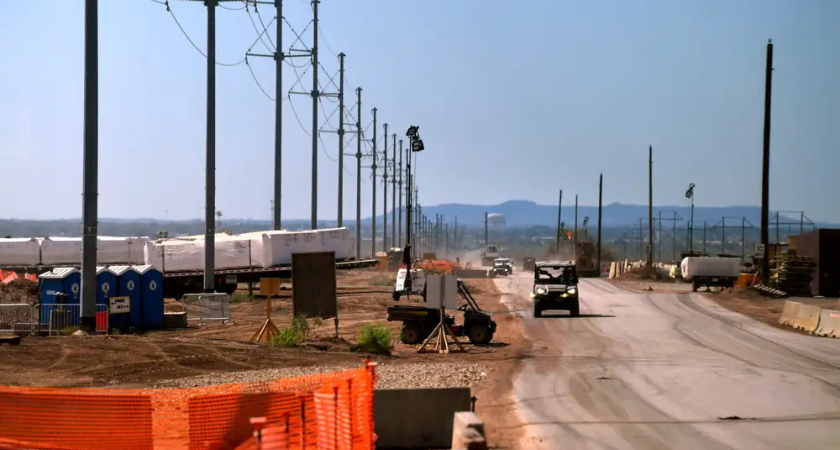
SHACKELFORD COUNTY, Texas (Oct. 23, 2025) — In a move that signals the next phase of the AI infrastructure revolution, Oracle and OpenAI are planning to power their second Project Stargate data center in Texas entirely off the public electrical grid. The facility will operate using a massive natural gas–powered microgrid, allowing it to come online faster and avoid long grid connection delays plaguing new developments nationwide.
The new data center — located in Shackelford County, roughly 40 minutes from the first Stargate site in Abilene — will be powered by hundreds of natural gas generators built and managed by Voltagrid, in partnership with Vantage Data Centers, the site developer. The off-grid system represents a significant shift in how AI data centers are being designed to handle skyrocketing energy demands.

According to documents obtained by Business Insider, the installation will feature an “onsite, behind-the-meter, gas-powered microgrid” that bypasses the strained U.S. power grid, allowing operations to begin potentially as soon as 2026.
The project “illustrates how the race to build AI infrastructure has reshaped the energy industry nearly overnight.”
This second Stargate facility follows the first one in Abilene, which also partially relies on natural gas generators for its power supply. The approach mirrors efforts by other tech leaders, including Elon Musk, who is using natural gas to power xAI’s Memphis data centers and planning a private gas plant in Mississippi as a long-term solution.
Public documents filed with the Texas Commission on Environmental Quality (TCEQ) show Voltagrid has been approved to operate 210 industrial gas generators at the Shackelford County site, with a combined capacity of 700 megawatts. Of these, 197 will be dedicated to primary power, while 13 will act as backup engines for emergencies. The generators, manufactured by Austrian engine maker Jenbacher, mark one of the largest microgrid deployments in U.S. history.
A spokesperson for Voltagrid confirmed that the completed microgrid will ultimately support up to 1.4 gigawatts of compute capacity, enabling OpenAI’s next phase of large-scale model training and AI infrastructure growth.
OpenAI CEO Sam Altman has previously stated his ambition to scale Project Stargate to more than 10 gigawatts of total compute power — an unprecedented goal that would rival the output of several large power plants combined.
Vantage Data Centers first revealed plans in August 2025 for the Shackelford County “mega-campus,” dubbed Project Frontier, which will feature 10 massive data center buildings totaling 3.7 million square feet. At the time, the company did not identify its tenant.
Documents obtained by Business Insider and confirmed by staff for U.S. Rep. Jodey Arrington, whose district includes the Abilene site, shed light on the project’s scale and secrecy. The “Oracle Fact Sheet” dated September 23, 2025, was distributed as part of a press kit during a site tour with state and local officials.
.jpg)
Brett Hedges, a spokesperson for Arrington, said the document came from a “press kit provided at the event.”
While Oracle and OpenAI declined to comment on power specifics for the Shackelford County data center, both Vantage Data Centers and Voltagrid confirmed their partnership roles to Business Insider.
The decision to build an independent energy system comes as AI-driven data centers increasingly strain existing utility grids across the U.S. The Lawrence Berkeley National Laboratory recently reported that in some regions, data centers face wait times of up to five years for a grid connection due to capacity limits and permitting backlogs.
By going “off grid” or operating “behind the meter” — the energy industry’s term for self-generated electricity — Oracle and OpenAI can bring their new facilities online faster while maintaining energy reliability and control.
The shift could also redefine how future AI campuses are built. Analysts say that the combination of AI-driven energy demand and sluggish grid modernization is pushing technology firms to become their own power producers. This trend has drawn attention from both energy regulators and environmental advocates, as most of these self-contained microgrids rely heavily on natural gas rather than renewable sources.
Still, companies argue that the use of efficient gas-powered systems is a necessary bridge while renewable and storage technologies scale to meet industrial AI workloads.
The Stargate Texas expansion highlights the intensifying arms race among Big Tech companies to secure computing capacity and energy reliability for artificial intelligence. With projects like this, OpenAI and Oracle are demonstrating how the traditional boundaries between tech, energy, and infrastructure are blurring at an accelerating pace.
Originally reported by Ellen Thomas in Business Insider.